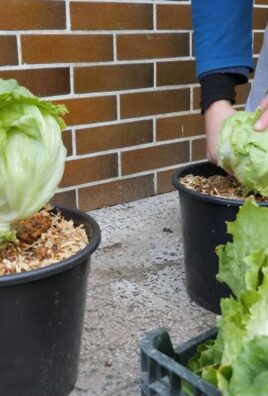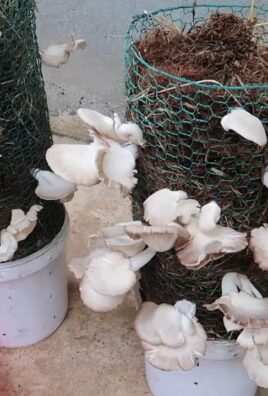Grow cucumbers abundant harvest, and imagine biting into a crisp, refreshing cucumber straight from your own backyard! There’s nothing quite like the taste of homegrown produce, and cucumbers are surprisingly easy to cultivate with a few clever tricks. For centuries, cucumbers have been a staple in diets around the world, with evidence of their cultivation dating back to ancient civilizations. From refreshing salads to tangy pickles, their versatility is undeniable.
But let’s be honest, sometimes getting a truly abundant harvest of cucumbers can feel like a challenge. Pests, diseases, and improper growing conditions can all stand in the way of your cucumber dreams. That’s where these DIY home gardening tricks come in! I’m going to share some simple yet effective hacks that will help you maximize your cucumber yield and enjoy a bumper crop all season long. Whether you’re a seasoned gardener or just starting out, these tips will empower you to grow the juiciest, most flavorful cucumbers you’ve ever tasted. Get ready to transform your garden into a cucumber paradise!

DIY: Unlock a Cucumber Bonanza – My Secrets to an Abundant Harvest!
Hey fellow gardeners! I’m so excited to share my tried-and-true methods for growing cucumbers that practically explode with deliciousness. Forget those measly few cucumbers you get from the store – we’re talking about a harvest so bountiful, you’ll be pickling, gifting, and eating cucumbers for weeks! This isn’t just about planting seeds; it’s about creating the perfect environment for your cucumber plants to thrive. Let’s dive in!
Choosing the Right Cucumber Variety
Before we even get our hands dirty, let’s talk about cucumber varieties. This is crucial! Not all cucumbers are created equal, and choosing the right one for your needs and climate makes a HUGE difference.
* Pickling Cucumbers: These are shorter and stubbier, perfect for, well, pickling! They have thinner skins and fewer seeds, making them ideal for absorbing brine. My go-to is the ‘National Pickling’ variety.
* Slicing Cucumbers: These are your classic long, smooth-skinned cucumbers that you find in salads. ‘Marketmore 76’ is a reliable and productive slicing cucumber.
* Burpless Cucumbers: If you’re sensitive to cucumbers (some people experience burping or indigestion), these are your best bet. They have a milder flavor and are easier to digest. ‘Sweet Success’ is a popular burpless variety.
* Bush Cucumbers: If you’re short on space, bush cucumbers are a lifesaver! They grow in a compact form, making them perfect for containers or small gardens. ‘Spacemaster’ is a great choice.
Pro Tip: Consider your local climate! Some varieties are more heat-tolerant or disease-resistant than others. Check with your local nursery for recommendations.
Preparing the Soil: The Foundation for Success
Cucumbers are hungry plants! They need rich, well-drained soil to produce a bumper crop. Here’s how I prepare my soil:
* Sunlight: Cucumbers need at least 6-8 hours of direct sunlight per day. Choose a sunny spot in your garden.
* Soil Testing: It’s always a good idea to test your soil to determine its pH and nutrient levels. You can buy a soil testing kit at most garden centers. Cucumbers prefer a slightly acidic to neutral pH (6.0-7.0).
* Amending the Soil: This is where the magic happens! I amend my soil with plenty of organic matter, such as compost, well-rotted manure, or leaf mold. This improves drainage, adds nutrients, and helps retain moisture.
* Fertilizing: Before planting, I also add a slow-release fertilizer that’s high in phosphorus and potassium. These nutrients are essential for fruit development.
Step-by-Step Soil Preparation:
1. Clear the Area: Remove any weeds, rocks, or debris from the planting area.
2. Loosen the Soil: Use a garden fork or tiller to loosen the soil to a depth of at least 12 inches.
3. Add Organic Matter: Spread a 2-3 inch layer of compost, manure, or leaf mold over the soil.
4. Incorporate the Amendments: Use a garden fork or tiller to mix the organic matter into the soil.
5. Add Fertilizer: Sprinkle a slow-release fertilizer over the soil according to the package directions.
6. Rake Smooth: Rake the soil smooth and level.
Planting Your Cucumber Seeds or Seedlings
Now for the fun part – planting! You can either start your cucumber seeds indoors or direct sow them in the garden. I usually direct sow because cucumbers don’t always love being transplanted.
* Starting Seeds Indoors (Optional): If you choose to start seeds indoors, sow them 3-4 weeks before the last expected frost. Use biodegradable pots to minimize root disturbance when transplanting.
* Direct Sowing: Wait until the soil has warmed up to at least 60°F (15°C). Sow seeds ½ inch deep and 2-3 inches apart. Thin seedlings to 12-18 inches apart once they have a few true leaves.
* Transplanting Seedlings: If you started seeds indoors, harden them off for a week before transplanting them into the garden. Dig a hole slightly larger than the root ball, gently remove the seedling from the pot, and place it in the hole. Backfill with soil and water thoroughly.
Step-by-Step Planting:
1. Choose Your Method: Decide whether you’ll direct sow or transplant seedlings.
2. Prepare the Planting Area: If direct sowing, create small mounds or rows in your prepared soil. If transplanting, dig holes large enough for the root balls.
3. Sow Seeds or Transplant Seedlings: Follow the spacing guidelines above.
4. Water Thoroughly: Water the newly planted seeds or seedlings gently but thoroughly.
5. Mulch (Optional): Add a layer of mulch around the plants to help retain moisture and suppress weeds.
Providing Support: Trellising for Success
Cucumbers are vines, and they need support to grow properly. Trellising not only saves space but also improves air circulation, reduces disease, and makes harvesting easier.
* Types of Trellises: There are many different types of trellises you can use, including A-frame trellises, vertical trellises, and even simple stakes. Choose a trellis that’s appropriate for the size and type of cucumber you’re growing.
* Installing the Trellis: Install the trellis before or shortly after planting. Make sure it’s sturdy enough to support the weight of the mature plants.
* Training the Vines: As the cucumber vines grow, gently guide them onto the trellis. You may need to tie them to the trellis with soft twine or plant ties.
Step-by-Step Trellising:
1. Choose a Trellis: Select a trellis that suits your needs and garden space.
2. Install the Trellis: Place the trellis firmly in the ground near your cucumber plants.
3. Guide the Vines: As the vines grow, gently guide them onto the trellis.
4. Secure the Vines (If Needed): Use soft twine or plant ties to secure the vines to the trellis.
Watering and Fertilizing: Keeping Your Cucumbers Happy
Cucumbers need consistent watering and regular fertilization to thrive.
* Watering: Water deeply and regularly, especially during hot, dry weather. Aim for at least 1 inch of water per week. Avoid overhead watering, which can promote disease. Drip irrigation or soaker hoses are ideal.
* Fertilizing: Fertilize every 2-3 weeks with a balanced fertilizer or a fertilizer that’s high in potassium. You can also use a liquid seaweed fertilizer for an extra boost.
Step-by-Step Watering and Fertilizing:
1. Water Deeply: Water the soil around the cucumber plants until it’s thoroughly moist.
2. Fertilize Regularly: Apply fertilizer according to the package directions.
3. Monitor Soil Moisture: Check the soil moisture regularly and adjust your watering schedule as needed.
Pest and Disease Control: Protecting Your Precious Cucumbers
Unfortunately, cucumbers are susceptible to a few pests and diseases. Here’s how I keep them at bay:
* Common Pests: Cucumber beetles, aphids, squash bugs, and spider mites are common cucumber pests.
* Common Diseases: Powdery mildew, downy mildew, and bacterial wilt are common cucumber diseases.
* Prevention: The best way to control pests and diseases is to prevent them in the first place. Choose disease-resistant varieties, practice good sanitation, and provide adequate air circulation.
* Organic Control Methods: If pests or diseases do appear, try organic control methods first. Insecticidal soap, neem oil, and copper fungicide are effective against many common cucumber problems.
Step-by-Step Pest and Disease Control:
1. Monitor Your Plants: Regularly inspect your cucumber plants for signs of pests or diseases.
2. Identify the Problem: Determine what pest or disease is affecting your plants.
3. Choose a Control Method: Select an appropriate control method based on the pest or disease.
4. Apply the Control Method: Follow the directions on the product label carefully.
5. Repeat as Needed: Reapply the control method as needed to keep pests and diseases under control.
Harvesting Your Bountiful Crop
This is the moment we’ve been waiting for! Harvesting your cucumbers at the right time is crucial for optimal flavor and texture.
* Harvest Time: Harvest cucumbers when they’re the desired size and color. Pickling cucumbers are usually harvested when they’re 2-4 inches long, while slicing cucumbers are harvested when they’re

Conclusion
So, there you have it! This simple, yet incredibly effective DIY trick for growing cucumbers is a game-changer for any gardener, regardless of experience level. We’ve walked you through the process, highlighting the benefits of increased yield, healthier plants, and a more manageable garden. But why is this a must-try? Because it addresses the core needs of cucumber plants: consistent moisture, proper drainage, and support for vertical growth. By implementing this method, you’re not just growing cucumbers; you’re creating an optimal environment for them to thrive.
Imagine biting into a crisp, juicy cucumber that you nurtured from seed to harvest, knowing that you played a direct role in its success. This DIY approach empowers you to take control of your garden and reap the rewards of your labor. It’s about more than just saving money; it’s about connecting with nature and experiencing the satisfaction of growing your own food.
But don’t stop there! Feel free to experiment with variations to suit your specific needs and preferences. Consider using different types of containers, such as fabric pots or repurposed buckets. Explore various trellising options, from simple bamboo stakes to elaborate wire structures. You can even incorporate companion planting techniques, such as planting marigolds or basil near your cucumbers to deter pests. The possibilities are endless!
This method is especially beneficial for those with limited space. Vertical gardening allows you to maximize your yield in a small area, making it perfect for balconies, patios, or even indoor setups. Plus, the improved air circulation around the plants helps to prevent fungal diseases, a common problem in humid environments.
We are confident that this DIY trick will transform your cucumber growing experience. It’s easy to implement, cost-effective, and yields impressive results. Don’t just take our word for it – try it yourself and see the difference!
We encourage you to embark on this gardening adventure and share your experiences with us. Let us know how this DIY trick worked for you, what variations you tried, and any tips or tricks you discovered along the way. Your feedback is invaluable and will help us refine and improve this method for future gardeners. Share your photos and stories on our social media channels using #DIYCucumberGarden. We can’t wait to see your abundant harvests!
Remember, growing cucumbers doesn’t have to be a daunting task. With a little ingenuity and this simple DIY trick, you can enjoy a bountiful harvest of delicious, homegrown cucumbers all season long. So, grab your seeds, gather your materials, and get ready to experience the joy of growing your own food! Happy gardening!
Frequently Asked Questions (FAQ)
What type of cucumbers work best with this DIY method?
This DIY method is versatile and works well with most cucumber varieties, including slicing cucumbers, pickling cucumbers, and even bush varieties. However, vining varieties, such as ‘Marketmore’ or ‘Spacemaster,’ will benefit the most from the vertical support provided by this method. Bush varieties, while not requiring as much vertical space, can still benefit from the improved air circulation and drainage offered by container gardening. Consider the size and growth habit of your chosen variety when selecting your container and trellising system.
How often should I water my cucumbers grown using this method?
Watering frequency depends on several factors, including the weather, the size of your container, and the type of soil you’re using. Generally, cucumbers need consistent moisture, especially during hot weather. Check the soil moisture daily by sticking your finger about an inch into the soil. If it feels dry, it’s time to water. Water deeply until water drains out of the bottom of the container. Avoid overwatering, as this can lead to root rot. Mulching around the base of the plants can help retain moisture and reduce the need for frequent watering.
What type of fertilizer should I use for my cucumber plants?
Cucumbers are heavy feeders and require regular fertilization to produce a bountiful harvest. A balanced fertilizer with an NPK ratio of 10-10-10 or 14-14-14 is a good starting point. You can also use a fertilizer specifically formulated for vegetables. Apply fertilizer according to the package instructions, typically every 2-3 weeks. Consider supplementing with compost tea or liquid seaweed extract for added nutrients and micronutrients. Avoid over-fertilizing, as this can burn the roots and harm the plants.
How do I prevent pests and diseases from affecting my cucumber plants?
Prevention is key when it comes to pests and diseases. Start by choosing disease-resistant cucumber varieties. Ensure good air circulation around the plants by spacing them properly and providing adequate support. Regularly inspect your plants for signs of pests or diseases, such as aphids, squash bugs, or powdery mildew. If you spot any problems, address them promptly with organic pest control methods, such as insecticidal soap or neem oil. Avoid overhead watering, as this can create a humid environment that encourages fungal diseases. Companion planting with herbs like basil or marigolds can also help deter pests.
Can I grow cucumbers indoors using this DIY method?
Yes, you can grow cucumbers indoors using this DIY method, but you’ll need to provide adequate light. Cucumbers require at least 6-8 hours of direct sunlight per day. If you don’t have a sunny window, you’ll need to supplement with grow lights. Choose a self-pollinating cucumber variety, or hand-pollinate the flowers yourself. Ensure good air circulation and maintain a consistent temperature. Indoor cucumber plants may also be more susceptible to pests, so monitor them closely.
What do I do if my cucumber plants are not producing fruit?
There are several reasons why your cucumber plants may not be producing fruit. One common cause is lack of pollination. If you’re growing a non-self-pollinating variety, you’ll need to hand-pollinate the flowers or rely on bees and other pollinators. Another possible cause is nutrient deficiency. Make sure you’re fertilizing your plants regularly with a balanced fertilizer. Stressful conditions, such as extreme heat or drought, can also inhibit fruit production. Ensure your plants are receiving adequate water and protection from the elements. Finally, check for pests or diseases that may be affecting the plants’ ability to produce fruit.
How do I know when my cucumbers are ready to harvest?
The size and color of your cucumbers will vary depending on the variety. Generally, cucumbers are ready to harvest when they are firm, smooth, and have reached the desired size. Avoid letting them get too large, as they can become bitter and seedy. Harvest cucumbers regularly to encourage continued production. Use a sharp knife or pruning shears to cut the cucumbers from the vine, leaving a small stem attached.
Can I reuse the soil from my cucumber containers for other plants?
It’s generally not recommended to reuse soil from cucumber containers for other plants without amending it first. Cucumber plants can deplete the soil of nutrients, and the soil may also harbor pests or diseases. If you want to reuse the soil, amend it with compost, aged manure, or other organic matter to replenish nutrients and improve drainage. You can also sterilize the soil by baking it in the oven or solarizing it in the sun. However, it’s often best to start with fresh potting mix for each growing season.
How does this DIY method help with growing cucumbers?
This DIY method helps with growing cucumbers by providing optimal conditions for their growth. The container provides good drainage and allows you to control the soil quality. The vertical support of the trellis encourages air circulation, which helps prevent fungal diseases. It also maximizes space, making it ideal for small gardens or balconies. The method also makes it easier to manage pests and diseases, as you can easily inspect and treat the plants. Overall, this DIY method promotes healthier plants and a more abundant harvest.





Leave a Comment